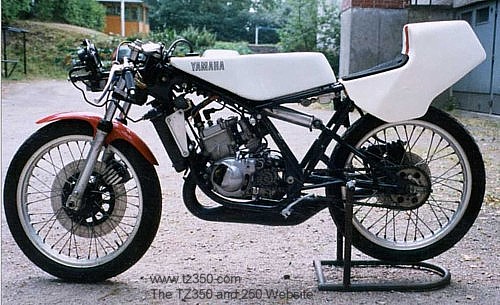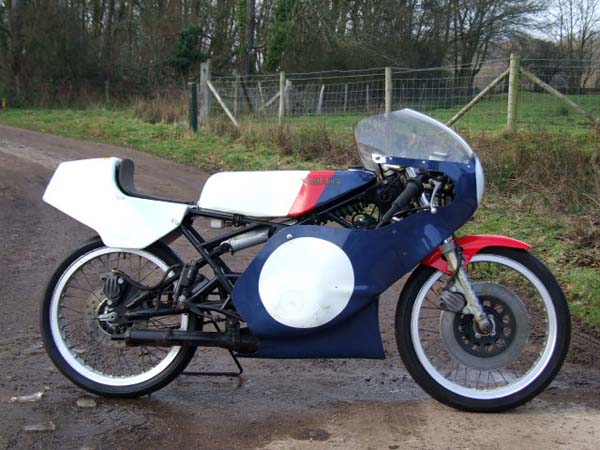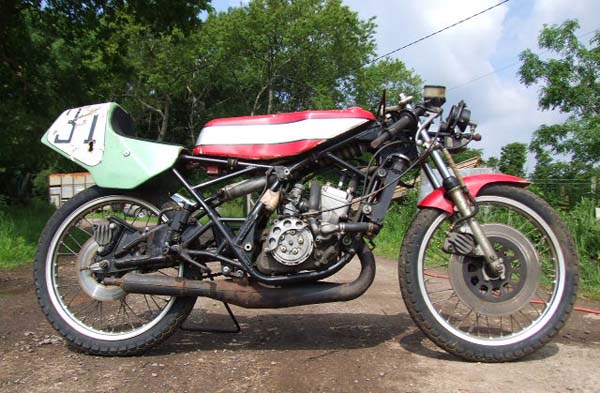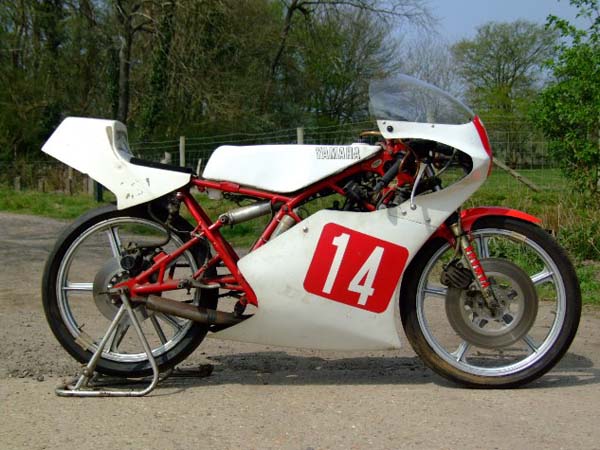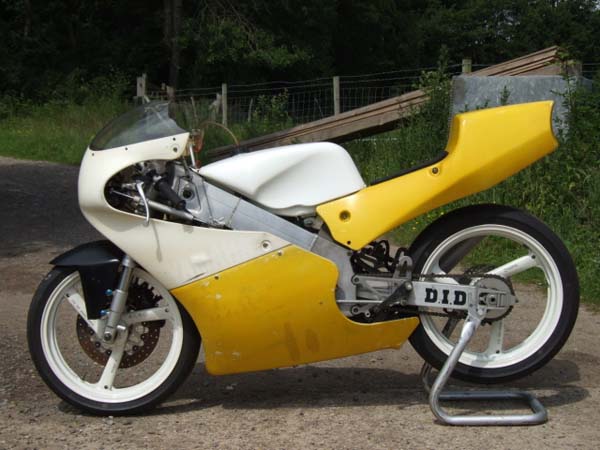|
|
||||||||||||||||||||||||||||||||||||||||||||||||||||||||||||||||||||||||||||||||||||||||||||||||||||||||||||||||||||||||||||||||||||||||||||||||||||||||||||||||||||||
 |
 |
 |
||||||||||||||||||||||||||||||||||||||||||||||||||||||||||||||||||||||||||||||||||||||||||||||||||||||||||||||||||||||||||||||||||||||||||||||||||||||||||||||||||||
 |
|
 |
||||||||||||||||||||||||||||||||||||||||||||||||||||||||||||||||||||||||||||||||||||||||||||||||||||||||||||||||||||||||||||||||||||||||||||||||||||||||||||||||||||
|
ВЕРНУТЬСЯ В МОТОКАТАЛОГ
|
||||||||||||||||||||||||||||||||||||||||||||||||||||||||||||||||||||||||||||||||||||||||||||||||||||||||||||||||||||||||||||||||||||||||||||||||||||||||||||||||||||||
| Yamaha TZ 125-250 | ||||||||||||||||||||||||||||||||||||||||||||||||||||||||||||||||||||||||||||||||||||||||||||||||||||||||||||||||||||||||||||||||||||||||||||||||||||||||||||||||||||||
|
Мотив появления TZ125 и TZ250 вполне ясен: только очень мощная фирма может себе такое позволить. Это яркий пример того, когда само дело становится лучшей рекламой одновременно и товару, и компании. Такие необычные и крайне расходные в финансовом плане шаги необходимы в тех конкурентных условиях, которые сложились на рынке автомототехники современной Японии. И в результате в абсолютном выигрыше остаётся потребитель, вокруг которого и происходит борьба. Yamaha TZ250, как и его младший брат TZ125 действительно уникалены не только потому, что выпускаются, мягко говоря, ограниченным тиражом, но и потому, что компания Yamaha в течение месяца рассматривает поступающие заявки и только потом оповещает счастливого будущего владельца о возможности приобретения. Смысл же производства столь малотиражных и, следовательно, очень дорогих моделей в том, что на них опробуются самые современные технологические решения и не все из них внедряются в серии. Компания-производитель внимательно изучает отклики, поступающие от потенциальных потребителей, и имеет возможность вовремя скорректировать проект. Именно на таких эксклюзивных аппаратах тесту подвергается дизайнерское решение внешнего облика мотоцикла. То есть, сам выпуск модели является лишь началом серьёзной исследовательской работы, которую ещё только предстоит выполнить компетентным специалистам Yamaha. Нешуточная борьба происходит в Японии за право обладать эксклюзивным TZ250, при этом цена на него составляет 2 100 000 иен. За такую сумму можно купить четыре обычных мотоцикла с сопоставимым объёмом двигателя. Но почему именно 2,1 миллиона иен, а скажем не 5 или 6? Ведь ясно, что покупатель и в этом случае заплатит. Дело в том, что стоит Yamaha именно заявленных денег. При здоровой рыночной конкуренции понятие чести для производителя дороже всего.
Некоторые характеристики TZ250 2007:
Размеры нового Yamaha: максимальная длина – 1955 мм; ширина – 650 мм; высота – 1 163 мм. Расстояние между осями – 1342 мм. Вес мотоцикла – 102 кг. Двигатель двухтактный, двухцилиндровый V-образный с водяным охлаждением, карбюраторный. Объём – 249 куб. см. Он обладает необыкновенной мощностью – 93 л. с. при 12500 оборотах в минуту. Для его размещения применено нестандартное конструкторское решение, а именно, алюминиевая Delta Box-рама. Ёмкость топливного бака – 23 литра, масляного – 0.5. К сожалению, нет информации о расходе топлива. Коробка передач шестиступенчатая. Размеры колёс – 120/60R17 – переднее и 160/55R17 – заднее. Yamaha TZ250 рассчитан на одного человека.
Характеристики TZ125 2007:
Размеры Yamaha вполне обычны: наибольшая длина – 1825 мм; ширина -510 мм; высота – 1033 мм. Расстояние между осями – 1242 мм. Вес мотоцикла всего 72.3 кг. Рассчитан на одного человека. Двигатель даже не имеет собственного обозначения, возможно, это секрет. Известно, что он карбюраторный, двухтактный с водяным охлаждением. Объём – 124 куб. см. При 12 000 оборотах в минуту он демонстрирует мощность равную 44 л. с., что само по себе впечатляет. Ёмкость топливного бака – 13 литров, масляного – 0.3л. О расходе топлива информация отсутствует. Да и вряд ли она будет актуальна. Трансмиссия шестиступенчатая. Размеры колёс – 95/70R17 – переднее, 125/55R17 – заднее.
Технические характеристики Yamaha TZ250 и TZ125 2008:
- габариты: 1,955
мм×650 мм×1,163 мм (TZ250); 1,828 мм×510 мм×1,033 мм (TZ125) Специальный выпуск TZ250 составляет 18 экземпляров; TZ125 выпущен в количестве всего лишь 7 экземпляров. Мотоцикл TZ250 можно будет приобрести за 2 100 000 иен, а TZ125 – за 1 047 900 иен.
Yamaha TZ 125-250 2003
|
||||||||||||||||||||||||||||||||||||||||||||||||||||||||||||||||||||||||||||||||||||||||||||||||||||||||||||||||||||||||||||||||||||||||||||||||||||||||||||||||||||||
 TZ250 TZ250
 TZ125 TZ125
|
||||||||||||||||||||||||||||||||||||||||||||||||||||||||||||||||||||||||||||||||||||||||||||||||||||||||||||||||||||||||||||||||||||||||||||||||||||||||||||||||||||||
|
|
||||||||||||||||||||||||||||||||||||||||||||||||||||||||||||||||||||||||||||||||||||||||||||||||||||||||||||||||||||||||||||||||||||||||||||||||||||||||||||||||||||||
Источник: http://www.tz250racing.com/2003TZ250/main.htm
|
||||||||||||||||||||||||||||||||||||||||||||||||||||||||||||||||||||||||||||||||||||||||||||||||||||||||||||||||||||||||||||||||||||||||||||||||||||||||||||||||||||||
| Yamaha TZ 250 | ||||||||||||||||||||||||||||||||||||||||||||||||||||||||||||||||||||||||||||||||||||||||||||||||||||||||||||||||||||||||||||||||||||||||||||||||||||||||||||||||||||||
|
Yamaha TZ250 Gallery
The TZ series of 250 racing motorcycles underwent successive updates to ensure that they remained competitive both on the world stage and at a national level. In addition to the efforts of the factory, various specialist tuners were able to extract more performance for riders seeking that elusive edge over their rivals. In addition to tuning, other firms provided components to enable the machines capacity to be increased enabling it to compete in larger classes, a facility that was of great benefit to privateers.
Yamaha TZ250E
Introduced in 1978, the 'E' version of Yamaha's all-conquering TZ250 production racer featured a new chassis frame. Retaining the same 'monoshock' rear suspension layout (complete with adjustable pre-load and compression damping) as its forebears, it relocated the famous twin-cylinder, two-stroke water-cooled engine some 20mm further forward. Mounted on special alloy plates, this remarkable unit boasted Hitachi's automatically advancing / retarding CDI ignition system and Mikuni VM34SC carburettors. Reputed to develop 53bhp @ 10,500rpm, it was mated to a six-speed gearbox and reined in by front / rear disc brakes. A stepping stone in the careers of such riding greats as Kenny Roberts and Tom Herron etc, the TZ250's influence reverberates to this day.
The History of the Modern TZ250
With the success of Kenny Roberts and the 500cc GP machines of the late 1970's, Yamaha had found itself in a position to capitalize on the wealth of technology they had accumulated developing their championship winning bikes. Unlike the 500cc bikes however, Yamaha's existing 250cc designs had been unreliable and flawed, requiring new pistons after every race and large sums of money for the expensive parts and services needed to keep them running fast.
In 1981 Yamaha was ready to introduce an all new TZ250. Known as the TZ250H, this design incorporated the powervalves found on the 500, providing more of a sensible balance between power and reliability. The new engine ran backwards from the previous design, helping even further in reliability. The single casting crankcase was replaced with left and right case halves and power was then tapped from the center of the engine. This design yielded a lower piston speed resulting in less bottom end problems. The powervalves employed a mechanical-governor design which kept them closed up to 8,750 rpm, opening fully by 11,000 rpm. This allowed a free flow of all exhaust gases.
This new TZ was expensive but well worth it for GP Racers. By the end of the 1981 season, the new machine proved to be very comparable the championship winning KR250 Kawasaki. Quite a leap compared to what had been.
Through continued trials and errors Yamaha continued this basic design for several years and by 1983 Kawasaki had abandoned it's KR250 program, pulling out of 250GP racing altogether.
Kenny Roberts now was running his own 250 race team, introducing Wayne Rainey to his first taste of World GP. Yamaha had taken notice of several deficiencies in the L model and had been supplying Team Roberts with special kits to keep their bikes competitive. The kits failed miserably.
1984 marked the last time a Yamaha 250 was to win the World Chamionship in the 1980's. Honda began releasing their all new RS250 in 1985. This bike was the TZ's undoing. With 70HP and it's own twin-spar aluminum frame, the RS250 proved to be a far better design. Yamaha had seen this coming and in the TZ250N had attempted to match the call. The design once again failed miserably. The N model utilized reeds which proved too small and too heavy. Cylinder redesigns also proved themselves flawed and the TZ250N seemed rather lethargic. New exhaust and carburetion failed to help. Minor suspension upgrades were far from adequate to compensate for the poor performance of the engine.
Through 1985 both Honda and Rotax began mopping the track with the TZ's. Freddie Spencer on his RS250 only making matters more obvious.
The YZR250 seemed to be a definate improvement. However, several problems were found to be rather troublesome. The new bike was extremely difficult to start. Most top racers on the Yamaha found themselves at the back of the pack starting races, leaving them to use the improved power and handling of their machines to work their way to the leaders near the end of a race. Although this made for exciting racing, it was not the preferred modus operandi.
Through a series of arguements and studies, 1988 saw the introduction of an entirely different parallel twin, the TZ250U. Both Cylinders were turned 180 degrees. The exhaust now shot straight out to the rear, with the carburetors poking out on the front. This design gave a cooler intake charge and moved the balance of the engine further forward and lower to the ground. A single casting crankcase was used. Yamaha decided to leave the chassis alone, with very few exceptions. This new TZ recieved a comparatively warm welcome from racers around the world. Although far from perfect, it seemed a fresh change and a glimmer of hope for Yamaha.
1989 saw the TZ250W make its debut, improving on the successes of the U model and addressing some minor issues. Better brakes, servo-driven power jets and internal strengthening of engine components.
This new design proved better than the RS250, but on World GP levels the battle was still being fought between the Honda NSR and the YZR250.
Although the writing seemed to be on the wall, Yamaha still kept the paralell twin TZ for 1990. The TZ250A enjoyed a smaller crankcase and a more robust water pump. There were a few new issues, such as vibration problems and motor mount cracking, but on the whole the A model was a popular design. The A model proved to be a competitive machine, winning the Isle of Mann race at an average of 115mph. Nonetheless, with the success of the YZR, Yamaha had to make a decision. The TZ was becoming rather expensive to build and although it was popular, there were drawbacks to producing two completely different powerplants for what was essentially the same chassis. By the end of the year it was decided to join the two programs and share production costs. In this way the TZ would not only be less expensive for the privateer racer, but both bikes could become more focused machines.
The new design was somewhat groundbreaking. The engine was now an integral part of the entire chassis. Front fork tubes were now upside down. The swingarm recieved major modifications, including the upwards curve on one side to clear the lower cylinder's expansion chamber. The rear wheel was widened to 5.25". This new TZ saw a healthy showing in US and British racing. In World GP however, the YRZ250 was having a tough time holding off the Aprilias and NSRs.
1992 saw the release of the TZ250D and the final major step in the evolution of what most consider the modern TZ250.
Modifications to the D model included a major redesign of the rear suspension. The subframe now served nothing more than to support the rider. More tunability in the front forks, along with port changes in the cylinders added to the success of this model. With these revisions, the TZ250D was once again highly popular with Privateer racers in the US and UK. Not to anyone's surprise, the 1992 Isle of Mann TT race was won by a D model TZ250.
The 1993 TZ250E offered minor updates to the D model. A wider front wheel, re-mapped ignition and cylinder port updates kept the bike up to date. Brembo cast brake rotors were now used.
For 1994 Yamaha remapped the ignition curves, introduced a thinner gas tank and updated the cylinder ports. The bodywork got a slight streamlining and the rear subframe was now detachable. Rear wheel width was widened again, checking in at 5.5". These minor changes made a big difference on the track. The new ignition maps gave more grunt when needed and resulted in a much more responsive TZ.
1995 saw the TZ get a few minor updates. Shortened Carbs, modified port timing and redesigned chambers. The exhaust canisters were lengthened and the ignition now had an additional map.
Yamaha tried a few new major changes in 1996 with the introduction of a slightly redesigned frame and fairing. Fresh air intakes were routed to the two unsealed airboxes from intake ports along the leading edges of the upper fairing. Chassis updates included rake/trail, fork hardware and Marchesini (magnesium) wheels with an increased rear axle diameter. The ignition was once again remapped. Frame construction was changed, with the cast head of the 4DP(92-95) models replaced by a built-up head with an extra aluminum sheet welded to the top of the steering head/spar joint area. A large cast rear section frame section replaced the built-up construction of the 1995 and earlier models. The revised rear frame section allowed the shock to be mounted more vertically to make room for larger airboxes. Although the swingarm picked up an additional side brace, the length remained the same as the 92-95 TZs. A new shock linkage was fitted. A curved radiator was fitted. The pipes, cylinders, heads, and ignition were improved while the crank and cases were unaltered. Cylinder ports were beefed up a bit to prevent stress cracks as was a common problem for previous models.. Rearsets were altered to become interchangeable side to side.
The 1999 model year brought no changes to the TZ, these would have to wait a year.
2000 was the year that the TZ finally abandoned it's old TZR-based engine cases in favor of a fresh new design. The new cases were sand-cast, with many riders experiencing much shorter case life. The 2000 crank was changed to a square 54x54mm configuration, with corresponding changes to the cylinders, heads, pistons, ignition, and pipes. The body work was identical to the 98/99 models, while the frame, being outwardly similar, was infact modified to take advantage of the smaller crankcase. The radiator was identical to earlier the 1996+ models, with new hose routing. The temperature and RPM gauges were combined into a single unit, and the old bourdon tube water temperature sensor was replaced with an electronic pickup. A radial master cylinder was fitted, although the 4-pot Nissin calipers were identical to the 1989+ bikes.
2001 brought modifications to the cases, aimed at resolving the reliability issues reported in the 2000 cases.
New bodywork in 2002 was very similar to the factory-supported MotoGP bikes. The 2002 air intakes were now both high on the front fairing on either side of the number plate and radial calipers were fitted to modified front forks.
The TZ has continued in its slow evolution and every year sees a faster more refined machine. Several changes have occured since 2002 and will be chronicled here in the coming months. Stay tuned!
Источник: http://www.tz250racing.com/history_of_the_tz250_2.php
|
||||||||||||||||||||||||||||||||||||||||||||||||||||||||||||||||||||||||||||||||||||||||||||||||||||||||||||||||||||||||||||||||||||||||||||||||||||||||||||||||||||||
|
Yamaha TZ150
|
||||||||||||||||||||||||||||||||||||||||||||||||||||||||||||||||||||||||||||||||||||||||||||||||||||||||||||||||||||||||||||||||||||||||||||||||||||||||||||||||||||||
|
|
||||||||||||||||||||||||||||||||||||||||||||||||||||||||||||||||||||||||||||||||||||||||||||||||||||||||||||||||||||||||||||||||||||||||||||||||||||||||||||||||||||||
| Yamaha TZ 125 | ||||||||||||||||||||||||||||||||||||||||||||||||||||||||||||||||||||||||||||||||||||||||||||||||||||||||||||||||||||||||||||||||||||||||||||||||||||||||||||||||||||||
|
Yamaha TZ125 Gallery
Технические характеристики Yamaha TZ125 2008:
- двигатель: двухтактный, одноцилиндровый, жидкостное охлаждение -
объем: 149 куб. см. - карбюратор:
PWM38×1 - тип рамы: diamond - габариты: 1,828 мм×510 мм×1,033 мм - сухой вес: 72.3 кг
|
||||||||||||||||||||||||||||||||||||||||||||||||||||||||||||||||||||||||||||||||||||||||||||||||||||||||||||||||||||||||||||||||||||||||||||||||||||||||||||||||||||||

 В
2007 году Ямаха анонсировала продажу на территории Японии всего 22 единиц
эксклюзивного дорожного мотоцикла Yamaha TZ250 и несколько мотоциклов –
TZ125. Выпуская таким тиражом эти модели, Yamaha не то, что и думать
не может о прибыльности проекта, но и, безусловно, несёт серьёзные убытки.
Научно исследовательские и опытно-конструкторские работы стоят огромных
денег, а представленные модели являются, по сути своей, реальным
воплощением таких разработок.
В
2007 году Ямаха анонсировала продажу на территории Японии всего 22 единиц
эксклюзивного дорожного мотоцикла Yamaha TZ250 и несколько мотоциклов –
TZ125. Выпуская таким тиражом эти модели, Yamaha не то, что и думать
не может о прибыльности проекта, но и, безусловно, несёт серьёзные убытки.
Научно исследовательские и опытно-конструкторские работы стоят огромных
денег, а представленные модели являются, по сути своей, реальным
воплощением таких разработок. 












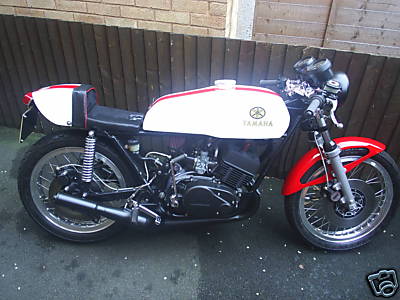


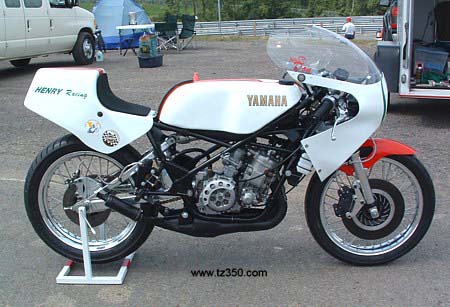
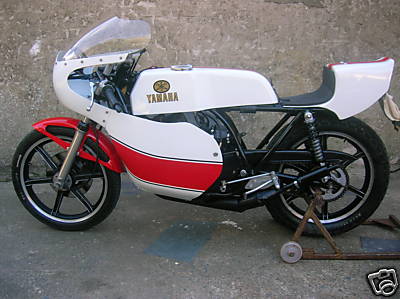


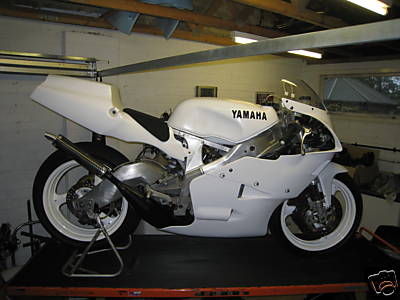













































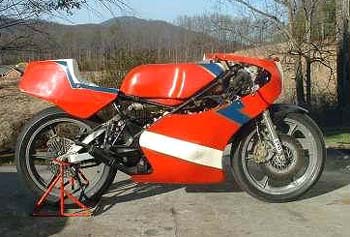
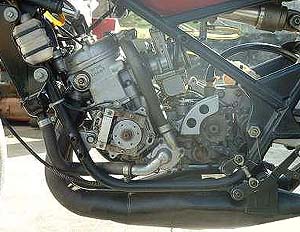
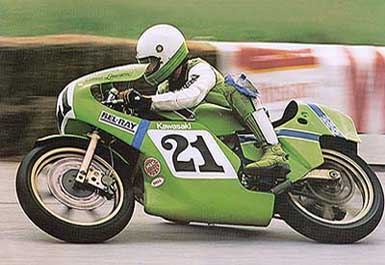 Carburetion
was updated with new Mikuni ZC units. The new TZ frame was 6.5 pounds
lighter, with the engine positioned slightly forward of previous designs. A
new rear shock and reduced rake angle added to the TZ's improved ride. Wire
wheels were offered for the first time since the mid 1970's.
Carburetion
was updated with new Mikuni ZC units. The new TZ frame was 6.5 pounds
lighter, with the engine positioned slightly forward of previous designs. A
new rear shock and reduced rake angle added to the TZ's improved ride. Wire
wheels were offered for the first time since the mid 1970's. 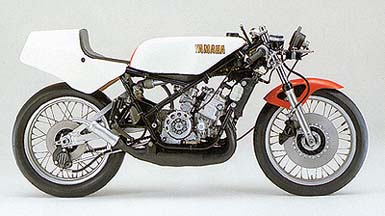 1984
saw the release of the TZ250L. This design moved the engine further even
still, placing more weight on the front wheel. To prevent tank slapping,
the swingarm and wheelbase was legnthened 40mm. Electrically driven
powervalves and rejetted carbs improved performance considerably, putting
out over 60HP. Again the cost of the new TZ went up.
1984
saw the release of the TZ250L. This design moved the engine further even
still, placing more weight on the front wheel. To prevent tank slapping,
the swingarm and wheelbase was legnthened 40mm. Electrically driven
powervalves and rejetted carbs improved performance considerably, putting
out over 60HP. Again the cost of the new TZ went up. 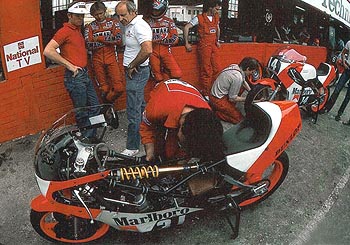 A
former racer named Hans Hummell, however, had been designing his own TZ
cylinders with great success. The Hummell cylinders used no powervalves.
Another designer named Harold Bartol had also been having success with his
own cylinders. These featured reed valves and were tested by the Roberts
team, although not actually raced. Kenny Roberts had also been
experimenting with twin-spar aluminum frame designs. Such designs were
beginning to appear on some Suzuki 500's from Italy along with some Rotax
bikes. These new frame designs were visions of what was to come for all 250
machines.
A
former racer named Hans Hummell, however, had been designing his own TZ
cylinders with great success. The Hummell cylinders used no powervalves.
Another designer named Harold Bartol had also been having success with his
own cylinders. These featured reed valves and were tested by the Roberts
team, although not actually raced. Kenny Roberts had also been
experimenting with twin-spar aluminum frame designs. Such designs were
beginning to appear on some Suzuki 500's from Italy along with some Rotax
bikes. These new frame designs were visions of what was to come for all 250
machines.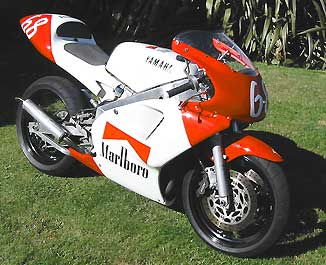 By
1986 Yamaha saw the need to address some serious problems in the TZ.
Several successful TZ racers over the previous 2 seasons had been
experimenting with V-Twin powerplants. Yamaha took notice and the result
was a new approach. Both the powerplant and frame were reworked. The
monoshock rear suspension was replaced with a single rising-rate unit. The
new aluminum delta box frame was refined for the monoshock suspension. Reed
valves were changed from 4 to 6 petals. The new V-twin engine was
essentially a V-4 from the YZR500 sliced length-wise down the middle. 2
35mm flat slide Mikunis were now used. This new bike was to be known as the
YZR250. As a full factory machine, Yamaha now regained the ability to
atleast contend for the 250 Chamionship. Not to be outdone, Honda
had just introduced the NSR250. A lighter, more powerful version of the
RS250. Things were going to heat up.
By
1986 Yamaha saw the need to address some serious problems in the TZ.
Several successful TZ racers over the previous 2 seasons had been
experimenting with V-Twin powerplants. Yamaha took notice and the result
was a new approach. Both the powerplant and frame were reworked. The
monoshock rear suspension was replaced with a single rising-rate unit. The
new aluminum delta box frame was refined for the monoshock suspension. Reed
valves were changed from 4 to 6 petals. The new V-twin engine was
essentially a V-4 from the YZR500 sliced length-wise down the middle. 2
35mm flat slide Mikunis were now used. This new bike was to be known as the
YZR250. As a full factory machine, Yamaha now regained the ability to
atleast contend for the 250 Chamionship. Not to be outdone, Honda
had just introduced the NSR250. A lighter, more powerful version of the
RS250. Things were going to heat up.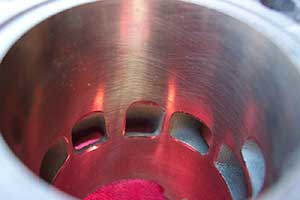 The
TZ250T would remain a parallel twin for 1987, but with some
significant improvements. The T Model featured improved carburetion, larger
reeds and a new exhaust. Carburetors were still rearward facing with the
exhaust leaving through the front of the cylinder bank. For the YZR250,
however, only the ignition and starting issues recieved attention. As a
result, the Hondas still outperformed the Yamahas.
The
TZ250T would remain a parallel twin for 1987, but with some
significant improvements. The T Model featured improved carburetion, larger
reeds and a new exhaust. Carburetors were still rearward facing with the
exhaust leaving through the front of the cylinder bank. For the YZR250,
however, only the ignition and starting issues recieved attention. As a
result, the Hondas still outperformed the Yamahas.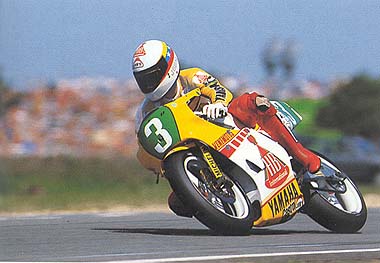 By
1990 the YZR had distinguished itself clearly from the parallel-twin
TZ. Luca Cadalora, Alex Criville and now John Kocinski were proving the
merits of the YZR design. With both factory and non factory "tweaks" being
implemented on these GP machines, there was much to be learned. The YZR had
finally proven itself in GP racing by upsetting the domination that Honda
had enjoyed for several seasons.
By
1990 the YZR had distinguished itself clearly from the parallel-twin
TZ. Luca Cadalora, Alex Criville and now John Kocinski were proving the
merits of the YZR design. With both factory and non factory "tweaks" being
implemented on these GP machines, there was much to be learned. The YZR had
finally proven itself in GP racing by upsetting the domination that Honda
had enjoyed for several seasons. 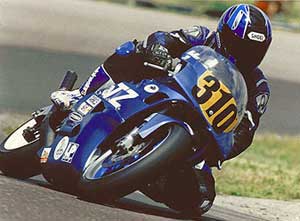 1991
was perhaps the real beginning of a new era for the TZ250. Utilizing the
proven designs of the YZR and the practical aspects of the previous TZ,
Yamaha produced what was to be a groundbreaking motorcycle. Essentially a
revamped TZR250, the TZ250B reintroduced the V-twin, offering a narrower
engine and producing power much more smoothly than its parallel twin
predecessor. Guillotine exhaust valves and 38mm Mikuni flat slide
carburetors were carried over from the previous TZ. Better cooling along
with redesigned intake and exhaust ports were applied. A counter balancer
was now used with this V Twin. These changes produced an engine with much
better mid-range power but less top-end than the A model.
1991
was perhaps the real beginning of a new era for the TZ250. Utilizing the
proven designs of the YZR and the practical aspects of the previous TZ,
Yamaha produced what was to be a groundbreaking motorcycle. Essentially a
revamped TZR250, the TZ250B reintroduced the V-twin, offering a narrower
engine and producing power much more smoothly than its parallel twin
predecessor. Guillotine exhaust valves and 38mm Mikuni flat slide
carburetors were carried over from the previous TZ. Better cooling along
with redesigned intake and exhaust ports were applied. A counter balancer
was now used with this V Twin. These changes produced an engine with much
better mid-range power but less top-end than the A model.


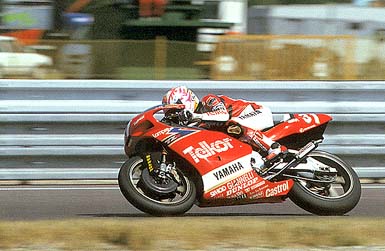 With
what seemed almost impossible odds, Tatsuyo Harada shook up the GP scene by
winning the 1993 250 World GP Chamionship on a Yamaha TZ250-M. A works bike
that was now much more similar to the TZ250 than any other previous YZR.
With
what seemed almost impossible odds, Tatsuyo Harada shook up the GP scene by
winning the 1993 250 World GP Chamionship on a Yamaha TZ250-M. A works bike
that was now much more similar to the TZ250 than any other previous YZR.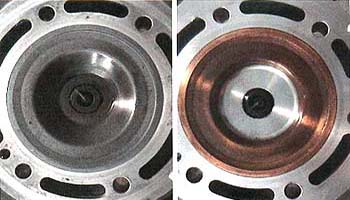 Due
to mixed reviews on handling, Yamaha changed the chassis setup back to 1995
specs for the 1997 TZ250, with the exception of a longer
swingarm. This was the first year of an TZ set up to run on unleaded fuel,
as mandated by the FIM. As such, the ignition, heads, and pipes were
modified from the 1996 model. The squish band to piston clearance was
increased, compression dropped, and the shape of the combustion chamber was
changed. Cylinders were unchanged. The swingarm was lengthened 20mm by
moving the axle slot rearward, and a revised linkage was fitted. A toe
guard was added to the swingarm. The cast top triple clamp was replaced by
a nice machined piece. Larger front rotors were fitted (298mm), with
calipers unchanged. The bike's geometry was changed back to 1995 specs,
Many riders changed the heads and ignition back to 1996 specs in areas
using leaded fuel. The 1997 kit ignition is said to be very similar in
timing and advance to the 1996 stock ignition.
Due
to mixed reviews on handling, Yamaha changed the chassis setup back to 1995
specs for the 1997 TZ250, with the exception of a longer
swingarm. This was the first year of an TZ set up to run on unleaded fuel,
as mandated by the FIM. As such, the ignition, heads, and pipes were
modified from the 1996 model. The squish band to piston clearance was
increased, compression dropped, and the shape of the combustion chamber was
changed. Cylinders were unchanged. The swingarm was lengthened 20mm by
moving the axle slot rearward, and a revised linkage was fitted. A toe
guard was added to the swingarm. The cast top triple clamp was replaced by
a nice machined piece. Larger front rotors were fitted (298mm), with
calipers unchanged. The bike's geometry was changed back to 1995 specs,
Many riders changed the heads and ignition back to 1996 specs in areas
using leaded fuel. The 1997 kit ignition is said to be very similar in
timing and advance to the 1996 stock ignition.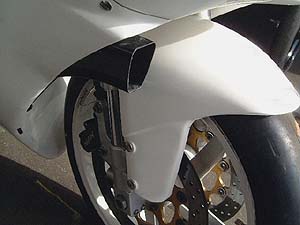 1998
was the first year for the ram air/sealed
airbox intake. Bodywork was again changed, and the famous TZ droop tail was
added. Crank, cases, heads, and ignition carried forward. Pipes and
cylinders were again changed. The carbs were new, with the old modified
flat slide replaced by an oval slide, and the powerjet solenoid moved to
the carb body. A fuel pump and small battery were added, as required by the
pressurized induction. The rear brake fluid reservoir mounting was moved
from the subframe to a cutout in the main frame. The steering stops moved
from the lower triple clamp to up near the top clamp, by way of adjustable
allen-bolt stops built into the frame.
1998
was the first year for the ram air/sealed
airbox intake. Bodywork was again changed, and the famous TZ droop tail was
added. Crank, cases, heads, and ignition carried forward. Pipes and
cylinders were again changed. The carbs were new, with the old modified
flat slide replaced by an oval slide, and the powerjet solenoid moved to
the carb body. A fuel pump and small battery were added, as required by the
pressurized induction. The rear brake fluid reservoir mounting was moved
from the subframe to a cutout in the main frame. The steering stops moved
from the lower triple clamp to up near the top clamp, by way of adjustable
allen-bolt stops built into the frame.
